INSIDE SANCTUARY MANDELA
Choreographed, calming neutrality where the Madiba dynamism is MIA
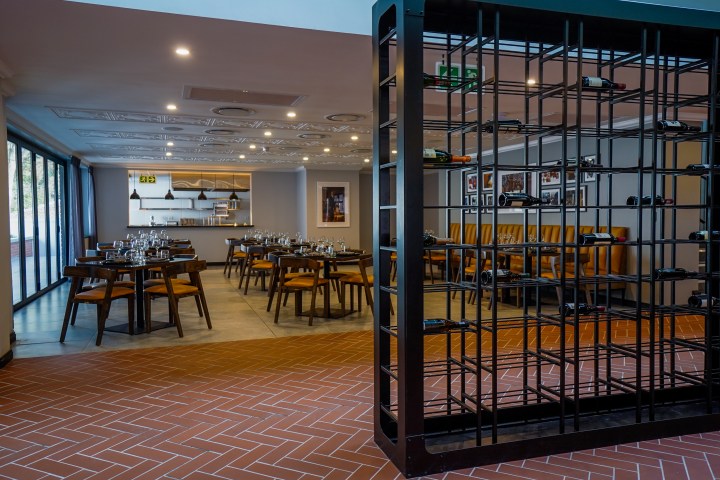
At Sanctuary Mandela the menu feels like a missed opportunity to eat delicious traditional South African food and engage with Madiba’s understanding of cuisine and hospitality. The fare at Madiba’s table was so good that Bill Clinton once jokingly tried to poach his chef for the White House. So, why are we changing it now?
Nelson Mandela lived at number 4 Thirteenth Avenue, Houghton Estate, Johannesburg between 1992 and 1998, after which he moved into another house a few blocks up the road. The Thirteenth Avenue home has recently been converted by the Motsamayi Tourism Group and the Nelson Mandela Foundation into what its website calls “a re-envisioned residency, a one-of-a-kind boutique hotel with nine curated rooms offering retreat spaces for reflection, healing and thought-provoking experiences inspired by the life and times of Nelson Mandela”. In practice this means meeting rooms, a salt-water swimming pool and Insights Restaurant @ Sanctuary Mandela which is open to inhouse guests and day visitors.
What any individual finds thought-provoking in the life of another is entirely subjective and generally says more about them than the object of their inspiration, but here are some of the thoughts that a visit to Sanctuary Mandela provoked in me…
It is undoubtedly an admirably ambitious endeavour. It would have been simpler (but much less interesting) to set up the space as a museum or a Mandela-Disney style venture where guests can sit in the great man’s chair and have their picture taken next to a cardboard cutout. The custodians of 4 Thirteenth Avenue are to be congratulated for not engaging in tired, potentially trite or tacky exploitation of an icon but rather seeking to support guests on a Mandela-inspired journey towards insight into their own issues.
The problem with ambitious ideas is that it’s really hard to get right. In order to succeed, the space must distill biography into meaning, then ambience and hospitality. Clearly, the curators of the space intend guests to consider Madiba’s whole life rather than just the six years he stayed at number 4 Thirteenth Avenue. Since South Africa’s de facto founding father lived to be 95 years old, that is a deep well of inspiration to draw from. Deciding which elements to highlight and which to leave out is almost impossible – especially with a life that means so much to so many in such a plethora of different ways.
So how have they done? Ja, well no fine. More than fine actually. Pretty well. Even as I find some fault with the project, I am aware that Sanctuary Mandela is already doing all of the above with infinitely more grace, substance and skill than other similar spaces – the (slave built) plantation houses of US Presidents George Washington and Thomas Jefferson come to mind.
All hotel openings are a process of learning what works for whom, when and why, but already, only a month into operations, Sanctuary Mandela is no worse than other retreat type boutique hotel spaces. The herb garden is coming along nicely, the bedrooms have all the right mod-cons and the security guard at the gate is super smiley. The trouble is that Sanctuary Mandela will be and should be held to a higher standard. For this venture to work, there must surely be the unique sense of Nelson Mandela about the place and, for me, he was notably MIA.
The ambience has been choreographed into such tasteful, calming neutrality that the man who once lived there, the dynamic, dangerous period during which he stayed at the house and the lessons that we might learn from both are unnervingly absent. I suspect that these elements have been left deliberately hazy because the intention is for each guest to be free to make their own mindful journey but I found the result so vague that there was nothing upon which to build site-specific reflection.
Like I said, inspiration is in the mind of the beholder but personally I don’t look to Madiba for soothing tones and salt-water pools. Others may have an equally valid but totally different understanding of Nelson Mandela but, for me, what sets Madiba and his comrades apart is their dynamism. They glow with vibrant, results-orientated, profoundly strategic, political energy. This drive and determination was especially apparent in the period 1992-1998. They knew they had one shot at achieving the almost impossible and they went at it with a fierce, focused intensity. Madiba and his comrades (for he was always a member of a wider ANC collective) were buzzing with the spirit of Ubuntu – not in some gentle, abstract way but rather the sense that I am because we are committed to actively creating a better life for all.
Capturing some of that drive and determination could be extremely inspiring – especially in light of the current lack of leadership around modern issues such as the climate crisis – but I didn’t find it at Sanctuary Mandela. While I am at it, I understand that it is hard from the perspective of 2021 to feel the way it was in 1994, but shouldn’t there have been a bit more black, green and gold about the place? Perhaps I missed it but the history of the ANC seemed substantially sidelined. I hold no particular torch for the ruling party but our first democratic president did. He was a politician, not a patron saint.
It was not just in Mandela the politician that the space missed the mark for me. Families are complicated and families torn apart by a crime against humanity are especially so. The fight to reach each other across barriers built of trauma was seldom serene chez Mandela but that was a large part of Madiba’s personal project in the years that he lived at 4 Thirteenth Avenue. My understanding from talking to members of the Mandela family is that their long walk back to togetherness was often intense and uncomfortable. Obviously, there are issues pertaining to preservation of dignity. Visitors to Sanctuary Mandela neither need nor deserve the airing of family feuds. As his third wife Graça Machel observed: “The world needs symbols, probably nowadays more than before. He is a symbol and he is good at projecting what he represents, his values. But, at the same time, you have to look at him as a human being who has strengths and weaknesses. He is a symbol, that’s correct but he’s not a saint. Whatever happens to him, it is a mark of the liberation of the African people, particularly the South African people. He makes the point that he should be treated with dignity because he’s absolutely aware of what he represents.”
Keeping a respectful distance while simultaneously entering into personal space is a delicate balancing act but any project that literally allows guests to book into Madiba’s bedroom and claims to have his favourite food on the menu has set themselves up for such a challenge. Getting that right is their job.
In this context knowing how much “real life” hotel guests can and should be exposed to is not only about avoiding hagiography and disrespectful intrusiveness but also about the visitor experience. Many of us stay in hotels to get away from the messiness of everyday existence. Madiba’s grandsons Andile and Mbuso were tiny children when they moved into the Houghton house in 1993 but not many visitors want to step barefoot onto Lego bricks in the name of an authentic experience.
Equally unrestful is the mere thought of the vast volume of work undertaken by Madiba and his comrades in the years that he lived at 4 Thirteenth Avenue. Remember that Nelson Mandela was already 74 years old in 1992 and then think about his role in transferring and transforming the ANC’s social, political, military, educational liberation movement machine, spread over countries and continents into a South African-based political party. Consider the complexity of blending internal and exiled elements of the anti-apartheid struggle. Mull over the many struggle slogans that had to be translated into implementable policy positions. Plus, all the international tours to be undertaken in recognition of support given and to secure future funding. Add in the requirement to keep the ANCs broad church speaking as one through a complex negotiation process born out of what Allister Sparks described as a state of “violent equilibrium between a government that cannot be overthrown and a spirit of mass resistance that cannot be crushed”. Don’t forget the anxiety surrounding the paramilitary white right. Remember the reign of terror wrought by Inkatha in Natal and the metro trains and in townships of the East Rand. Bear in mind that many of those on the opposite side of the negotiating table had the advantage of being incumbents with all the machinery of government. So, they had almost all the fax machines and a state funded military machine that was actively involved in atrocities such as June 1992’s Boipatong massacre. By the end of 1992 (the year he moved into 4 Thirteenth Avenue) the Convention for a Democratic South Africa (Codesa) participants had agreed to the concept of a five-year power sharing agreement under a Government of National Unity. Aren’t you tired just thinking about it?
This is only the first half. All of the above had to happen before the first democratic election could take place and the real business of transforming, reconstructing and developing South Africa while coping with the apartheid debt and an uncooperative civil service could even begin. Those who would be willing to pay between R4,000 and R15,000 a night to acquire insight from the stress of all of the above are probably a niche, dark tourism sector of the hospitality market.
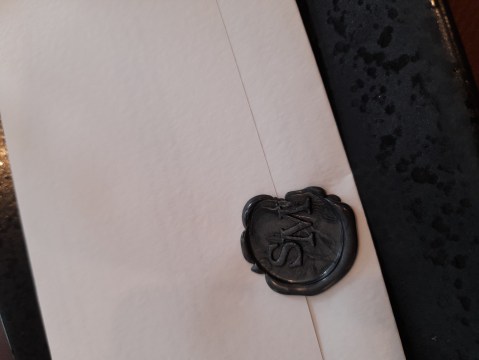
The menus were designed by Chef Ockert Brits (who has since left) based on dishes in Xoliswa’s cookbook Ukutya Kwasekhaya but all the items on the menu have been substantially reinterpreted as fine dining restaurant food.
And that’s not all, folks. Let’s also remind ourselves of why he moved to Houghton in the first place. Though they only legally divorced in 1996, Nelson and Winnie Mandela separated in 1992. Moving out of the Soweto home was the traumatic end to almost three decades of dreaming about sharing a life with the woman he loved. It was an acknowledgement that the life that they had both longed for, and deserved, was never going to happen.
In prison Madiba had developed a protective emotional carapace which meant that he was often better at warmth with strangers and crowds than with his immediate family. Most 74-year-old men separating from their wives have an accumulation of emotionally significant clutter with which to set up a new house. After a lifetime in jail, Madiba had almost nothing to take away from the Soweto residence he briefly shared with Winnie Madikizela-Mandela so his longtime friend and comrade Barbara Masekela decorated 4 Thirteenth Street in what she described as “an attempt to hide his pain”. She also hired Gloria Nocanda and Xoliswa Ndoyiya as housekeeper and cook respectively.
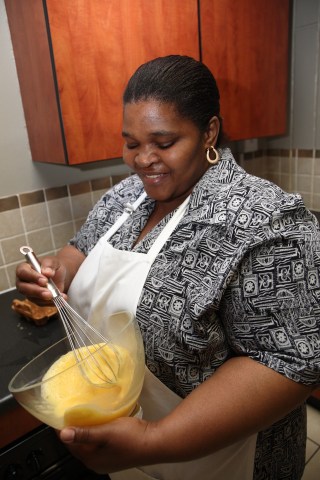
Xoliswa Ndoyiya cooked for Nelson Mandela. (Photo: Richard Goode)
Madiba insisted on interviewing the candidates for cook himself. Xoliswa says that he was very clear about what kind of food he was looking for when “he said to me ‘I believe you are a great cook but can you cook our food?’ Can you cook ukutya kwasekhaya? I replied that I can cook ukutya kwasekhaya and that was that; I got the job.” This Xhosa phrase translates literally as “home food” but carries connotations of comfort through traditional African tastes. In this case, specifically Eastern Cape heritage ingredients, cooking methods and recipes.
Before we proceed, let me declare my love for Xoliswa Ndoyiya. I have known and worked with her on various projects for a long time. I am not neutral when it comes to her lovely food but then neither is anyone who has ever eaten it. Including Madiba. Everyone who lived in or visited the house in those days not only remarked on the quality of the food served but also on how Xoliswa came to fill a crucial emotional space in Madiba’s heart. As his daughter Zindzi remarked, “they have an amazing rapport; he’s vested a lot of trust in Sis Xoli and he gets anxious if she’s not there. It’s not difficult to see why – her food is always so comforting. Her cooking makes a home out of a house”.

Madiba and Xoliswa Ndoyiya. (Photo: Debbie Yazbek)
In later years Graça Machel (whom Madiba married in 1998) would be extremely successful in mending broken emotional bridges but, in those early years, it was Xoliswa who created the softening buffer between young and old. As Tukwini Mandela observed: “She’s been our friend, our mother, our confidant. We’ve all sat in my grandfather’s kitchen and learnt from her. Not just about food and cooking but about life in general. I am particularly grateful for the way that she has helped us younger members of the family to know and understand my grandfather better. Her grace and insights have improved our relationship with him.”
Most of all she made it possible for Madiba to experience the lovely, chaotic, simple abundance of family life. Xoliswa remembers: “We were two ladies, my colleague Gloria Nocanda and I. We stayed in the house to look after him and then he asked us if we could please also take care of his grandchildren. He said he knows that the ANC employed us just to look after him but he would like to stay with the grandchildren. For that I respect him – he asked us first before he brought the children to the house. He asked us if we were happy with it. So, we said we were happy to give him this chance because we knew he hadn’t had the chance to bring up his own children so that’s how Mandla, Ndaba, Mbuso and Rochelle and Andile came to stay. So, we cooked, washed, cleaned. We took care of the kids making sure they went to school. Andile and Mbuso were very little babies in nappies and they slept with us in the cottage in the back until they were old enough to say ‘grandpa can I go to wee’ and then they would go to the main house. They were enjoying each other’s company … he didn’t have much time to be with them but he really enjoyed coming back to that noisy house with children.”
Of this time in his life, Mandlesizwe Mandela, who later became Nkosi Zwelivelile, recollected: “We moved in with him in ’93. We moved in for several reasons. Partly it was that my grandfather had been denied the opportunity to raise his own children being in prison. Partly it was that he put a lot of pressure on my father to go studying and so he went back into studying in his later years. In order to do that my grandfather assured my father that he would look after his children. So, my father was studying and my grandfather, he took myself and my three brothers in, and we stayed with him in Houghton. It was Sis Xoli and Sis Gloria were the two ladies who practically brought us up. For me, I came in when I was already 19 so they saw me through circumcision. Andile was about 10 months old so he was really a baby when he came. Mbuso was two years old and Ndaba must have been about nine so they really saw us grow over the years.”

Madiba’s letter to Xoli.
Even after 1994 when Madiba had an official Presidential residence in Pretoria he continued to return home every evening to his grandchildren in Houghton. As Ahmed Kathrada (Madiba’s long term comrade and then parliamentary counsellor) recalled: “Sometimes we’d be at some official function and I would really liked the look of those little canapés with salmon and so forth that they had put out but he would always say ‘let’s wait chaps. Let’s eat real food at home’.” When Madiba had to be away from home he had ukutya kwasekhaya sent to him – in 1996 he notoriously insisted on umphokoqo namasi (crumbly maize meal and soured milk curds) being smuggled from South Africa into the Dorchester Hotel in London.
Madiba didn’t save home food for old friends and family. Bill Clinton, Kenneth Kaunda, Naomi Campbell, Oprah Winfrey and a host of other great, good and not so good all got the ukutya kwasekhaya treatment. He brought his new staff home too. Kathrada described how: “Entering government was a new ball game for all of us but Mandela adjusted easily. He is a supremely confident person. Most people landing in a new situation are taken aback and take time to adjust. Not him. He settles in as if he is trained for everything. He has a commanding presence. When he gets into the office and meets new people he immediately establishes a rapport with them. For instance, some of the staff in Pretoria – especially the black staff but some whites too – had never shaken the hand of a minister, a prime minister or a president. Some had been working there for 20 years. Of the white staff, only the most senior had ever set foot in the official residence. Mandela put them at ease immediately by shaking hands with them, inquiring after their family circumstances. And very soon he started inviting these people to his home for meals. Unmarried ones were invited to bring their parents along.”
Why such a long description of Tata Madiba’s taste? What do these sweet stories from 1992-1998 have to do with Sanctuary Mandela in 2021? At the moment not very much. Xoliswa Ndoyiya has been employed under the title of Chef de Tournant which is an archaic French term for a chef who moves between various kitchen sections filling in and implementing instructions but not writing recipes or creating menus. The hotel’s PR people tell me that the menus were designed by Chef Ockert Brits (who has since left) based on dishes in Xoliswa’s cookbook Ukutya Kwasekhaya but all the items on the menu have been substantially reinterpreted as fine dining restaurant food. None of the Xhosa traditional food retains its original recipe or is presented as it was in Madiba’s day.
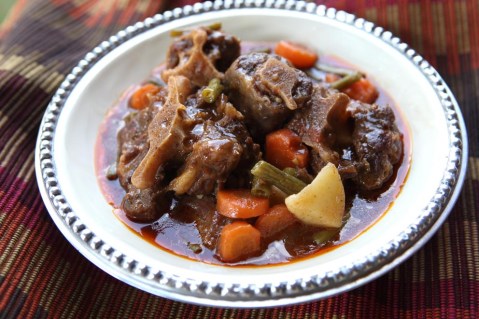
Sis Xoli’s oxtail as Madiba ate it. (Photo: Debbie Yazbek)
I tried a range of dainty dishes. Oxtail had been reimagined as three ravioli filled with beef ragout. Samp and beans (AKA “Umngqusho”) had morphed into a risotto-like mélange served with sugar snap peas, parmesan and pan-fried mushrooms. There was a plate listed on the menu as Ethiopian “kitfo” but was much more like French-style steak tartare (which is similar but not the same) and curiously came with an Indian roti not an Ethiopian injera bread. The raw meat starter is presumably in remembrance of Madiba’s early 1960s Ethiopian trip.
Everything I ate was skillfully executed and tasted very nice but I wasn’t left feeling embraced by the spirit of Mandela.
I have a long and greedy history of advocating for New African Cuisine, so I am all for fine dining adaptations where appropriate. In any other setting I would probably praise the plates but at Sanctuary Mandela the menu feels like a missed opportunity to eat delicious traditional South African cuisine and engage with Madiba’s understanding of food and hospitality. In other people’s houses the former president ate as they did and used those meals as an opportunity to understand and connect with them. In his home Madiba generously gave of himself and his culture through food.
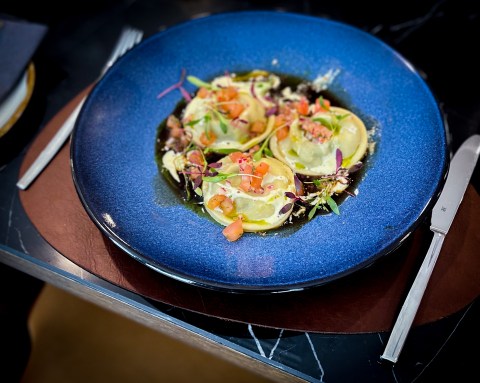
Sanctuary Mandela oxtail ravioli… decidedly not as Madiba ate it. (Photo: Steve Steinfeld)
Madiba didn’t feel the need to pretty up or modernise the oxtail when he fed it to Bill Clinton. Regardless of who was coming to dinner, if it was Wednesday, the table was set with umngqusho just as his mother had made it in Mvezo in 1918. On hot days everyone ate cooling umphokoqo namasi.
The food at Madiba’s table was so good that Bill Clinton once jokingly tried to poach his chef for the White House. So, why are we changing it now? There is perhaps a case for saying a hotel is not a home and that it must cater for a variety of tastes. Even in Madiba’s day, the Johannesburg-raised Mandela grandchildren often brought spare ribs and sugary breakfast cereals into the house so there is precedent for the availability of multiple food genres. If the hotel management are worried about meeting the needs of all customers why not keep the posh-nosh plates (which really do taste very nice) but add an extra section to the menu that serves original versions of the same culinary concepts?
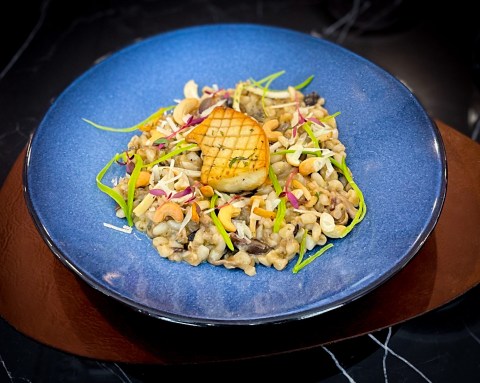
Sanctuary Mandela’s samp risotto with cashew nuts and mushrooms. (Photo: Steve Steinfeld)
An iconic location deserves iconic food and, in this context, samp “risotto” is not that. Perhaps it’s just me but if I am entering a “retreat space for reflection, healing and thought-provoking experiences inspired by the life and times of Nelson Mandela” I want to do so secure in the knowledge of where that experience is rooted. For that I need ukutya kwasekhaya… DM/TGIFood
Anna Trapido is the author of Hunger for Freedom; the story of food in the life of Nelson Mandela (Jacana).
The author supports The Saartjie Baartman Centre for Women and Children in Manenberg. Their 24-hour crisis response service provides holistic social work support which includes housing and feeding up to 120 survivors of domestic violence daily. SaartjieBaartmanCentre





 Become an Insider
Become an Insider
What a gem of a story. So enjoyed and appreciated this read. The depth of the author’s knowledge and the interesting personal details shared. And hearing from people directly involved with Madiba during that period. Thank you. As an outsider looking in, my feeling is, it would seem prudent for those running Sanctuary Mandela to read this piece and to do some tweaking, particularly around the food.
Thank you. Loved this insight into Madiba’s life and home. Agree 100% it should be as Sis Xoli served it. With some prettied-up stuff for those who can’t take the pace…!
Great article. Dainty dishes – ha ha. Mandela was a tough guy, a fighter – can’t see where “dainty dishes” fit in.